Chapter VII. Decoration Of Kites
Description
This section is from the book "Kitecraft And Kite Tournaments", by Charles M. Miller. Also available from Amazon: Kitecraft And Kite Tournaments.
Chapter VII. Decoration Of Kites
Kites may be decorated in three general ways. Piece work in covering; overlaying, called aplaca; and brush work. The decoration of kites presents some unique problems. The great distances at which the decorations are to be seen force a study of the carrying qualities of colors.
The star kite is probably the best for decoration, as the spacing falls in easier relationships than some of the other forms. In the kite shown in Fig. 116 the covering is applied so as to give a decorative effect, and it showed up splendidly in the air. The colors did not stand out as well as might be expected, however, and while high in the air it was nearly overlooked by the judges. When brought nearer it received the first prize. Another way of combining colors is to make one half one color and the other half another, giving a light and shade effect to each point, Fig.
117.
Fig. 37 shows a pleasing arrangement of spaces. The kite is first covered with the body color, then the bandings are put on, and lastly the spots. A banding around the outside of the stars in the tail is effective and in keeping. Passepartout is excellent for banding in some places.
The five-pointed star kite, Fig.
38, is neat and artistic. The framework is given to the left.
The Six-pointed Star, Fig. 118, has interesting spaces and paths.
The wide paths running to the center are divided by passe-partout.
The discs at the points are in keeping with the large one at the center.
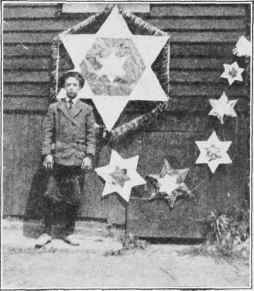
Fig. 116.
The main cover was in two tones of grey green. The one spine and two bowed tailless kite gives good opportunity for decoration. Fig. 119 is designed as a banner kite, Fig. 120 a conventionalized bull pup, and Fig. 121 a flower form. The two stick tailless kite is not as easy to space well as some of the others, yet a number of excellently decorated kites of this form, have been exhibited. Fig. 122 has a blue body and black paths with gilt over the black. The gilt was put on by hand. Fig. 123 is very similar in design but with light paths between dark. Fig. 124 has a red, white and blue combination with black paths and gilt stripes on the color spaces. In Fig. 125 the radiating lines would be curved in the air.
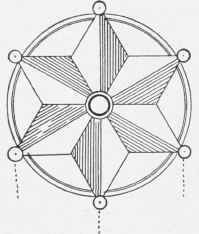
Fig. 117.
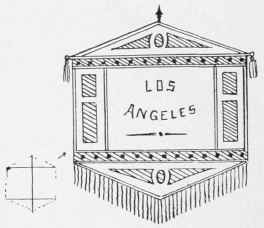
Fig. 119.
The Japanese square kite, Fig. 126, is like a canvas, ready for a grotesque figure, a beautiful landscape, or a conventional design, and many of these have been very artistically decorated.
For box-kites with bands as a part of their construction, the banding designs seem more consistent, and so are used more. See Figs. 127-133. Fish, bird, butterfly, boy, man, and clown kites and all forms of representative kites require considerable brush work. Fig. 134 is a beautiful brown kite all decorated with the brush. The school building in the center was painted with water colors. The fish kite, Fig. 135, is all hand work. Fig. 136 is the head for a dragon kite and should have considerable fierceness. Fig. 137 has the decorative feature in carefully planned lettering which possesses a good space filling quality.
Some very satisfactory results are obtained by using good colors, say blue and black, relieved with gilt. Red and white makes a pleasing combination, also red and black. A circle divided into three parts presents a little problem in color harmony analysis. There are three primary colors: red, yellow, and blue. We may use blue in a color scheme. Combining the other two colors, red and yellow, we get orange. Orange is called the complement of blue, but orange is too strong, and a better color harmony is formed by the addition of some of the third color, the blue to the orange, which will give a brown. Now brown and blue make a better color harmony than orange and blue. So it runs, two primary colors give a secondary, but the colors are more pleasing when subdued with the third color or by the addition of grey or white. Red and olive will need dividing paths of some strong color, black or white. When gilt is used it must be edged with black or some very dark color or it loses its effectiveness. While orange is too strong for combination with blue, it is good with black. When yellow is used with the purples it should be a modest yellow.

Fig. 118.
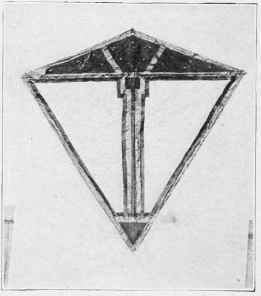
Fig. 122.
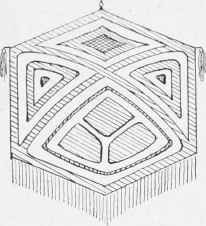
Fig. 120.


Fig. 121.

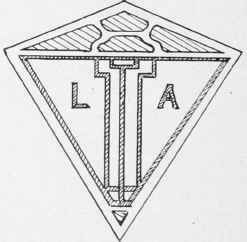

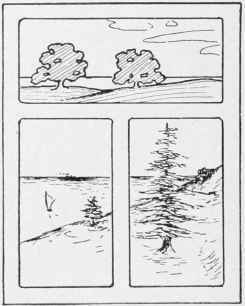
Figs. 123, 124, 125, 126.
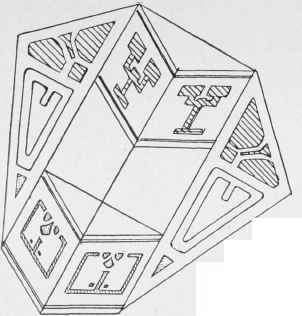
Fig. 129.

Fig. 128.
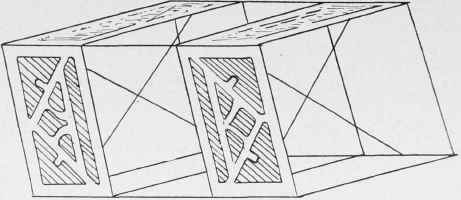
Fig. 127.
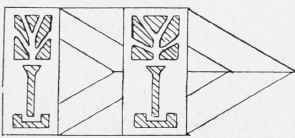
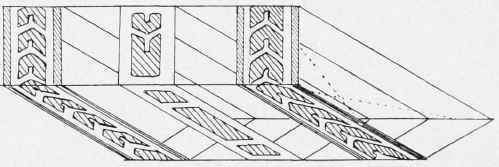
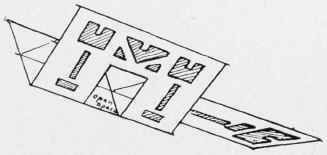
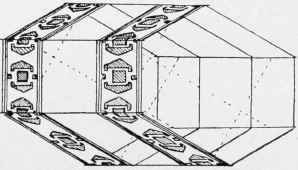
Figs. 130, 131, 132, 133.
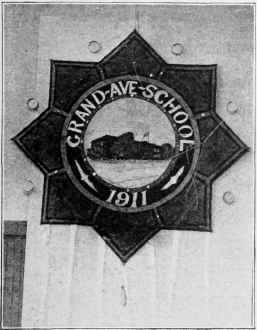
Fig. 134.

Fig.135
Just as in landscape where the highlights are warm colors, we seek a cool color for shadows, and vice versa, so with color combination we strike across the color circle and choose a warm and cool color for balance. Some of the analogous hues are very pleasing, but unless quite a little variation of color is used, the design soon loses out in the distance. Browns, greens, reds, blues, etc., may be used in their individual color schemes, but the throwing in of some opposite color has a spicing up effect that is helpful. A dark brown, medium brown, a dull yellow, and a light but not brilliant yellow, give a good combination. Some color schemes that are very beautiful for rugs and interior decoration do not carry far enough to be used on a kite. Some very brilliant colors that might shock us close by, are charming when far up in the air.
But this is not a treatise on color work, and the subject is so great, that we must leave it here. Sometimes striped effects are made with gummed papers similar to passe-partout. The little mirrors mentioned are such as are used on gowns and draperies. They are set in little rims of light brass and with a good allowance of paste may be stuck sufficiently well to any portion of the kite to hold during a tournament. The mirrors might be found at Chinese stores. Whirling devices, to be treated in a following chapter, may also be used for ornamentation. Tassels, streamers, and banners all serve a purpose of artistic makeup when properly used.
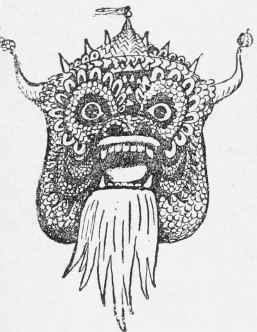
Fig. 136.

Fig. 137.
Continue to:


